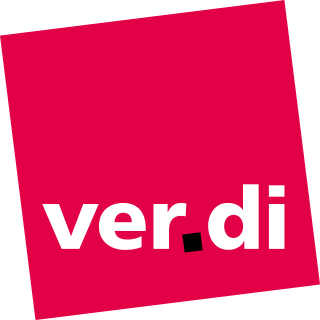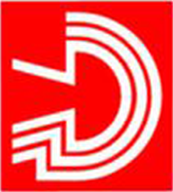Related Research Articles

Vereinte Dienstleistungsgewerkschaft is a German trade union based in Berlin, Germany. It was established on 19 March, 2001 as the result of a merger of five individual unions and is a member of the German Trade Union Confederation (DGB). With around two million members, Verdi is the second largest German trade union after IG Metall. It currently employs around 3000 members of staff in Germany and has an annual income of approximately 454 million Euros obtained from membership subscriptions. The trade union is divided into 10 federal state districts and 13 divisions and is managed by a National Executive Board (Bundesvorstand) with 14 members. Frank Bsirske has been the chairman of Verdi since its founding until September 2019, when he was replaced with Frank Werneke.

The Factory Workers' Union of Germany was a trade union in Germany.
Lothar Lindner is a former German trade union leader. He was chairman of the central committee of the building and timber industry union in the East German Free German Trade Union Federation and President of the International Federation of Unions in the building, timber and building materials industries in the World Federation of Trade Unions (WFTU).

The Media Union was a trade union representing German workers in the printing, paper, journalism and arts.

The Public Services, Transport and Traffic Union was a trade union representing transport and public service workers in West Germany.
The Arts Union was a trade union representing cultural workers in West Germany.
The Chemical, Paper and Ceramic Union was a trade union representing chemical, oil refinery, paper, rubber, ceramics, glass and plastics workers in West Germany.
Erwin Ferlemann was a German trade unionist.
The Union of Bookbinders and Paper Workers of Germany was a trade union representing workers involved in manufacturing paper and binding books in Germany.

The Union of German Book Printers was a trade union representing printers in Germany.
The Union of Lithographers, Lithographic Printers and Kindred Trades was a trade union representing printers in Germany. It was sometimes referred to as the Senefelder Union, after Alois Senefelder, the inventor of lithography.
The Industrial Union of Metal was a trade union representing workers in the metal and electronic industries in East Germany.
The Industrial Union of Mining and Energy was a trade union representing the mining, energy and water industries in East Germany.
The Industrial Union of Chemicals, Glass and Ceramics was a trade union representing workers in various industries in East Germany.
The Industrial Union of Printing and Paper was a trade union representing workers in the printing industry in East Germany.
The Wismut Industrial Union was a trade union representing workers at the Wismut uranium mining company.
Werner Peplowski is a former German trade union leader.
The Union of Printing and Paper was a trade union representing most printing industry workers in Switzerland.
The Swiss Lithographers' Union was a trade union representing printers in Switzerland.
Comedia was a trade union representing print and media workers in Switzerland.
References
- ↑ "IG Druck und Papier". Ver.di. Retrieved 13 November 2019.CS1 maint: discouraged parameter (link)
- 1 2 "Industriegewerkschaft Medien - Druck und Papier, Publizistik und Kunst (IG Medien)". Ver.di. Retrieved 13 November 2019.CS1 maint: discouraged parameter (link)
- ↑ Ebbinghaus, Bernhard; Visser, Jelle (2000). Trade Unions in Western Europe Since 1945. Basingstoke: Palgrave Macmillan. p. 310. ISBN 0333771125.